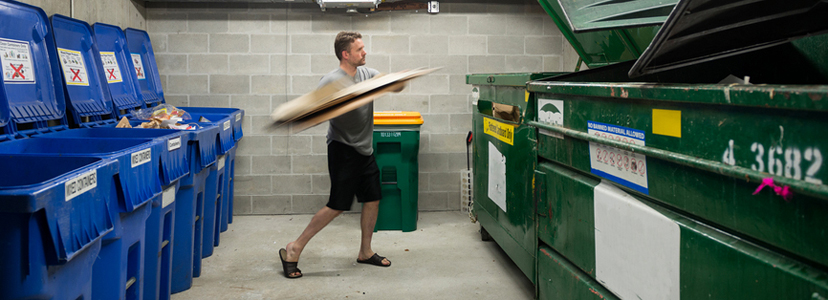Cardboard box recycling: what you need to know

The cardboard box is one of life’s essentials, both at home and at work. Shop owners receive goods in cardboard boxes, much of the food and drink we buy is encased in them, and such is the demand for them. There are many kinds available for a range of purposes.
What are the main types of cardboard box?
There are two main types of cardboard box: corrugated and non-corrugated.
Corrugated cardboard boxes have various applications. They may contain goods that are transported and stored in warehouses, from flat-pack furniture for the home to bottled and canned goods sold in supermarkets. They are also used for storage and archiving.
Boxes of different sizes and strengths are required for different purposes. They can range in size from very small (e.g. for mailing small, fragile gifts) to very large (e.g. for shipping house contents), and they can be single, double, or triple-walled. One wall comprises a fluted sheet and two flat sheets.
Their construction means they are sturdy, but lightweight. A large, triple-walled cardboard box will weigh less than its plywood equivalent, so it is particularly advantageous to use cardboard boxes when weight restrictions have to be met.
In the food industry, however, cardboard boxes aren’t corrugated, as non-corrugated cardboard offers more adequate protection for products such as cereals, sandwiches, and frozen pizzas.
Corrugated or not, there is one major plus point to using cardboard boxes: they can be recycled.
Is it important to recycle cardboard boxes?
Yes. Quite simply, cardboard box recycling is good for the environment. More recycling obviously means fewer trees being chopped down to provide the raw material for more cardboard boxes, but that’s not all.
Recycling diverts cardboard from landfill and incineration, thus reducing greenhouse gases. In landfill, cardboard biodegrades and releases methane; when burned, it produces carbon dioxide (CO2) — both gases contribute to climate change. According to the Waste and Resources Action Programme (WRAP), recycling one tonne of paper and cardboard will avoid 1.4 tonnes of CO2 equivalent (a measure of the impact a greenhouse gas has on global warming) from landfill or 0.62 tonnes from incineration.
Defra statistics show that, for the 12-month period ending September 2014, households in England threw out 5.8 million tonnes of waste. When you consider that 42% of this (2.4 million tonnes) was paper and card, the importance of recycling is clear.
It’s easy to recycle cardboard boxes too. Depending on where you live, cardboard may be collected with your household refuse, from a separate bin. Alternatively, your local household waste recycling centre may accept it, or you could take it to a community recycling point in your neighbourhood. Many supermarkets also have cardboard and paper recycling points in their car parks — so there isn’t really an excuse not to.
Recycling is also good for business. Through cardboard box recycling, companies can make savings by avoiding landfill tax (£82.60 per tonne) and demonstrate their commitment to corporate social responsibility.
Additionally, this also paints the business in a more favourable light to its customer base: sustainability is one of the most talked about packaging and recycling trends this year.
How are cardboard boxes recycled?
Various kinds of paper and cardboard may be mixed together for collection, but once everything reaches the recycling plant, it is sorted and graded. Once this has taken place, it is delivered to a mill where it is made into pulp with water — pulping separates the fibres.
The pulped fibres are then screened to remove contaminants, such as paper clips and staples, and then cleaned and de-inked. When the pulp is sufficiently clean, it is processed through rollers (or a vibrating machine) to remove most of the water, and then dried. Here, it may be mixed with non-recycled pulp, depending on the kind of end product that is required.
The dried pulp is then rolled into paper, which is then used to manufacture paper and card products, including more cardboard boxes.
According to the Confederation of Paper Industries, used paper accounts for more than 70 percent of the fibre used to make paper and board in the UK, so recycling makes a valuable contribution to the manufacturing process — as well as being good for the environment and your bottom line.
Should cardboard boxes ever not be recycled?
Recycling isn’t the only way to avoid landfill or incineration. You could reuse unwanted cardboard boxes by passing them on to your local school, so that they can be used in craft projects. You might store old books or CDs in a box, or even ‘upcycle’ one by decorating it with wallpaper and store art supplies or children’s toys inside it.
Sadly, not all cardboard can be recycled. Since water is used in pulping, the screening process cannot deal with grease as oil and water don’t mix well. Grease will stay on the fibres, resulting in poor quality recycled paper or card.
For this reason, cardboard boxes that have been contaminated with food waste — such as takeaway pizza or fried chicken boxes — should not be put into your recycling bin. Similarly, if you run a shop, and a bottle of cooking oil has leaked into a box, put that box in with your general waste.
Finally, make sure you keep your old cardboard boxes dry. Wet cardboard can clog up the machines that are used to sort it. As a result, an entire batch of recycling could be contaminated.
When you recycle your used cardboard boxes, you make a valuable contribution to both the British economy and the future of the planet, so please keep up the good work!
Rick Stanford
Latest posts by Rick Stanford (see all)
- Davpack’s Top Tips for Secure Strapping - 7th September 2022
- The Paper vs Plastic Bubble Wrap Debate - 10th August 2022
- Save Money with Royal Mail Sized Packaging - 8th July 2022
